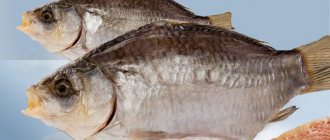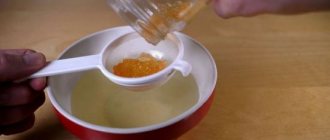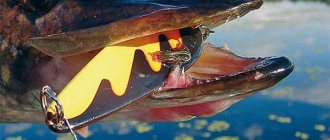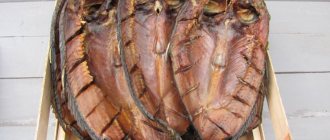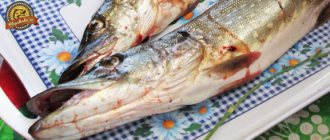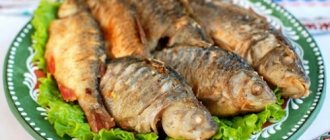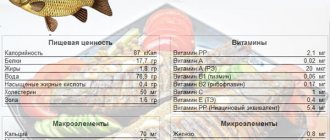Preliminary preparation
To salt the ram at home, no preliminary preparation of the carcasses is required. To prevent poisoning, any fish, even small ones, must be gutted, since freshwater fish feed on harmful organisms found on algae.
If the fish is not gutted, the carcasses will taste bitter and have a musty smell. The gills also need to be cut out; they can worsen the taste of the finished snack. When drying carcasses with brine with entrails, it is better to use live specimens; the fish swallows water, and the entrails are well salted.
Methods for salting fish before drying
Several methods of salting fish using the ram type are known.
You should not worry that the fish will be over-salted, because its meat will absorb exactly as much salt as required
Using brine
It is better to pickle a small ram in a strong concentrated brine called brine. The strength of brine can be checked with a raw egg. When the required concentration is reached, the egg will not sink. Keep the prepared fish in the marinade for 4 days, pressing it down with a wire rack with pressure so that the carcasses do not float to the surface.
The container with fish should be hidden in a cool place so that the preparation does not become rotten. The larger the fish, the longer it will need to be salted. It is better not to exceed the weight of the carcasses 500 g. After salting, it is better to soak the fish in cool drinking water. For small carcasses, 30 minutes of soaking is enough, but for large specimens it will take 2-3 hours.
During soaking, you should replace the water 2-3 times, allowing the carcasses to sit in the air for a while, so the salt will disperse evenly throughout the fibers. Soaking should be considered complete when the carcasses begin to float. Properly salted ram will turn out transparent with a light amber tone of meat.
Dry method
It is better to divide large carcasses into halves along the ridge for improved salting. Rub the fish with salt, pour crystals into the belly, into the gill openings, and into the slits on the back. Pour a layer of salt 0.5 cm thick into a stainless steel container, lay the ram on top of the salt in layers with its backs down, sprinkle the fish on top with salt 1 cm thick. For each 1 kg of fish you will need about 250 g of salt.
Place a slightly smaller plate on top and place pressure on it. Place the workpiece in a cool room: cellar or loggia. After 5-6 hours, the weight of the oppression can be increased so that the carcasses are salted evenly. During salting, liquid will appear that needs to be drained.
Carcasses weighing 100 g will be salted for 2 days; for fish weighing 800 g, 4 days are enough, and for large specimens – 15 days. When the juice stops oozing from the workpiece, the ram should be soaked for 2 hours in filtered drinking water.
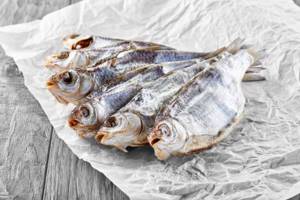
To remove possible bacteria, you need to soak the fish for 40 minutes in a vinegar solution of 50 ml of vinegar per 7 liters of water
How to salt carp in an unusual way: salted-dried fish
The fish is salted using the wet method so that it is salted quickly and is ready for use after a few hours, so only small carp are salted this way.
Ingredients
- Small carps;
- Salt;
- Seasonings: coriander, black pepper, bay leaf.
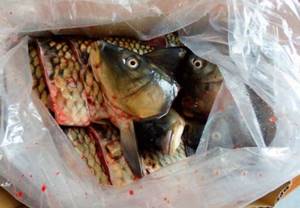
How to salt carp using the wet method
We salt them as follows:
- We clean the scales from the fish, gut them and wash them.
- Place the carps in layers in an enamel pan, sprinkling the layers with salt and seasonings.
- Cover the fish with a wooden circle (dish), set the weight and put it in the refrigerator (cellar). Lightly salted fish can be eaten within 24 hours.
- If you need well-salted fish, wait 6 days and rinse it directly in the pan with cold water to wash off excess salt. Rinse until the water is no longer cloudy.
- Fill the carps with water and leave for half a day to completely remove excess salt.
After draining the water, lay out paper towels in several layers and lay out the fish. We dry them for several hours in a dry and warm place: you get salted and dried fish, ideal for beer.
Now you know how to salt carp in different ways, which are also suitable for other types of fish. Try them to enjoy the delicate spicy taste and choose the most suitable technology for salting river and lake fish for the future.
Rules for drying rams
After salting and soaking is completed, the fish will need to be dried. To do this, twist a double thread, string a salted ram onto it at a distance of 7 cm, piercing the carcasses through the eye holes so that the fat and brine do not drain through the mouth hole.
If desired, drying can be done on hooks, and small fish can be placed on a wooden surface, turning as they dry. It is better to place threads with hanging carcasses in a room with good ventilation without direct sunlight.
After 2 days, the fish is considered dried, but the ram will become dried only after 14 days. The consistency of properly dried meat is neither soft nor tough, and has a pleasant aroma and taste. In the light, the ram glows slightly, there are no yellow marks on the skin.
Important! To protect from flies and insects, you can soak the fish in a vinegar solution, and also knock down the frame by covering it with a net.
Recipes from different fish varieties
Delicious taranka can be prepared from different types of fish. Each has a special taste, fat content and aroma.
From bream
How to dry fish correctly
Salting a taranka of fatty and delicious bream provides an excellent appetizer for foamy beer. Bream has a flattened body, which helps the fish to salt out faster and dry better.
For drying, you will need bream weighing about 600 g and no more than 30 cm long. Wash the carcasses thoroughly and pat dry with napkins. Fish should be salted at the rate of 2 kg of coarse salt per 10 kg of carcasses.
Coat the bream heavily with salt and place it tightly in a wooden box with holes, the bottom of which is covered with a layer of salt. The fish should also be salted, and pressure should be placed on the top layer of the bream under the salt, which will ensure the elasticity of the meat. Keep the workpiece in the cold for 7-10 days.
The amount of time to salt the bream depends on its size. Soak the salted bream in running water for 3 hours, then ventilate the fish in a dry place without direct sunlight. Using a large needle, thread the fish through the eye sockets, wrap the workpiece in a net and dry for about 14-16 days. Store fish in cloth bags or wrap the carcasses in parchment.
From crucian carp
Delicious crucian carp ram is an excellent snack for beer that any resident of the country can afford. You need to make the ram from medium-sized crucian carp and coarse salt. Gut each carcass and place it in a container with a layer of large salt crystals. Next, lay out the crucian carp, layering each with salt.
Cover the workpiece with 2 layers of gauze and place a bend in the form of a 5-liter eggplant on the surface. Place the container in a cold place for 3 days. Rinse each carcass from salt residues, soak for 2 hours and hang in a room with good ventilation for a week.

If there is an unpleasant odor or stickiness, the fish should not be consumed.
Perch
Rinse the perch thoroughly, clean the rough scales, remove the intestines, cut off the gills and dorsal fin. Place the salt-rubbed fish in rows on a layer of salt in an enamel container. Cover the top of the container with a lid and press down the structure with pressure.
Leave the perch to salt for 10 days, after which hang the fish by the head to dry in a place with good ventilation without bright sun and insects. Insert wooden sticks between the ribs to ensure ventilation of the pulp. In the same way, you can ensure the salting of roach and roach.
From carp
The main condition for preparing carp taranka is sunny weather and the presence of salt and seasonings. For 1 fish you will need 5 tbsp. l. coarse salt, a pinch of seasoning and freshly crushed black pepper. Cut out the carp's giblets, clean the scales, cut off the tail and fins. Rinse the carcasses thoroughly. Sprinkle the pulp with salt, crushed pepper and powdered fish spices.
Place the carcass under a press, put the structure in the refrigerator and on the second day drain the released brine. Keep the fish in the cold for 5 days. Afterwards, rinse the carcasses in water and hang them on a wire under a net to prevent insects from landing on the meat. Drying carp lasts about 6 days, the period depends on the outside temperature, the optimum is 18℃.
How to salt and dry crucian carp
Many people ask: how to deliciously pickle crucian carp? There are several secrets here: during salting, it is necessary to thoroughly rub the places where the entrails were located. The more salt the better. The next secret: do not take the ram out of the refrigerator ahead of time, and also do not try unsalted fish. Drying crucian carp should be done on the balcony, the main thing to remember is that it should be well ventilated, it is advisable that the sun’s rays do not fall on the suspended ram, and that insects do not land on it.
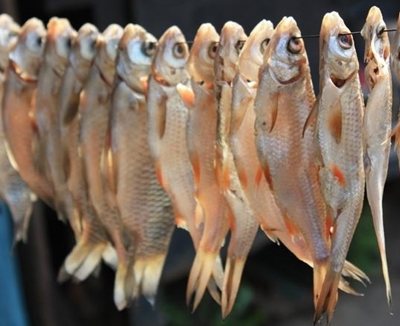
Secrets of gourmets
To properly cook fish, you need to follow simple gourmet advice:
- For cooking, you need to use large salt crystals, which are good at drawing moisture out of the fish. The less liquid remains in the carcass, the tastier the ram will be.
- Adding sugar to the brine recipe will add tenderness and piquancy to the meat.
- The weight of the load is optimally 5-15 kg, and in the summer it is better to wrap the workpiece in several layers of gauze.
- For better drying of the carcass, it is better to cut it after salting.
- To drain the liquid, you need to drill holes in the container, so you don’t have to scoop it out with your hands.
- You can collect beautiful fish bouquets from dried fish.
Principles of proper storage
Salted and dried ram should be stored for up to 4 months. It is better to place the carcasses in layers in sterile jars, cover them with lids and hide them in the basement for 10 months. You can also keep the ram in a bag, wicker basket, or parchment paper envelope. It is better to keep the workpiece in a cool place, avoiding plastic bags and foil, as this material does not allow the workpiece to breathe, causing the fish to spoil.
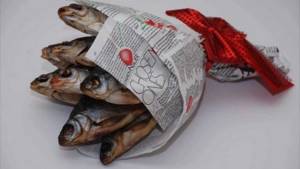
If the ram has become hard, it should be soaked and wrapped in parchment for a couple of days, sometimes sprinkling with water
In a refrigerator, fish should be stored in a fresh zone, while the carcasses should be coated with olive oil and placed in sterile jars. You cannot keep the ram in the air, as the fat in its composition oxidizes, and the fish acquires a rancid taste.
When the humidity is high, the fish becomes moldy, and when the humidity is low, it dries out. The best storage conditions are 80% moisture and temperature 4-6℃. The fish is stored for 10 months in a kraft paper wrapper, opened with polyethylene.
Salting ram at home: what is needed?
Firstly, there is enough fish so that you don’t mind wasting time and effort. Secondly, several kilograms of table salt - depending on how much fish you have, since salting 10 kg of ram will take at least 2 kg of salt.
Delicious recipe! Homemade oatmeal cookies recipes: simple, delicious, soft
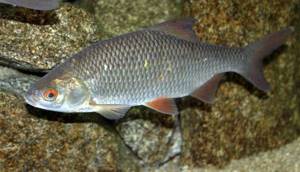
Thirdly, special equipment and the correct storage location: dry-salted fish is kept in wooden containers; For drying and drying, you will need wire or a special drying device.
Fourthly, proper climatic conditions in accordance with the technology for preparing the fish product: a constantly ventilated room, shade or sunny side, humidity and air temperature.
